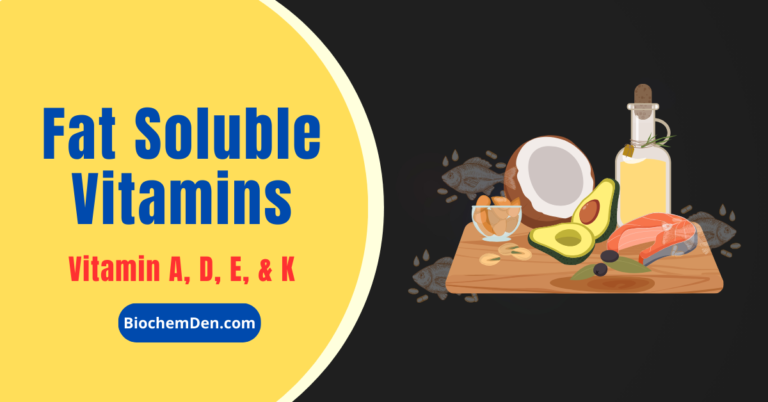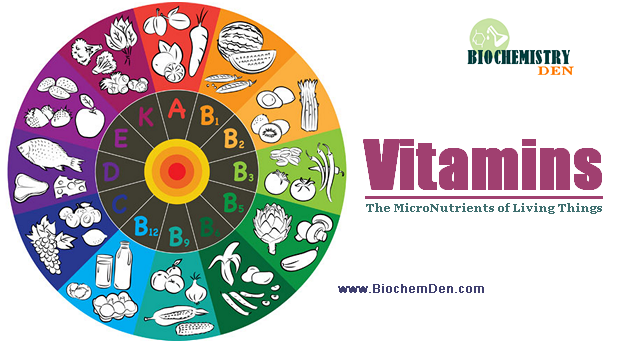Are you looking for the details of vitamin A Structure, functions, properties, and Deficiencies?
Vitamins are organic compounds occurring in small quantities in different natural foods and are necessary for the growth and maintenance of good health in human beings and in experimental animals. Basically, vitamins can be divided into two types based on solubility. Vitamins are vital amines.

They are
- Fat-soluble (vitamin A, D, E, and K)
- Water-soluble (B-Complex vitamins and vitamin C)
In this article, we are adding the details of vitamin A.
Historical aspects of Vitamin A
- Vitamin A was first isolated by McCollum, Davis Simmonds, and Kennedy in 1913.
- Richard Kuhn identified carotene and received the Nobel Prize in 1937.
- Vitamin A’s structure was elucidated by Paul Karrer in 1931.
Common names for Vitamin A
- Anti-xerophthalmic factor
- Bright eyes Vitamin
Other Names
- 3-Dehydroretinol,
- 3-Déhydrorétinol,
- Acétate de Rétinol,
- Antixerophthalmic Vitamin,
- Axerophtholum,
- Dehydroretinol,
- Déhydrorétinol,
- Fat-Soluble Vitamin,
- Oleovitamin A,
- Palmitate de Rétinol,
- Retinoid, Retinoids,
- Rétinoïdes, Retinol,
- Rétinol,
- Retinol Acetate,
- Retinol Palmitate,
- Retinyl Acetate,
- Rétinyl Acétate,
- Retinyl Palmitate,
- Vitaminum A
- Rétinyl Palmitate,
- Vitamin A Acetate,
- Vitamin A Palmitate,
- Vitamin A1,
- Vitamin A2,
- Vitamina A,
- Vitamine A,
- Vitamine A1,
- Vitamine A2,
- Vitamine Liposoluble,
Sources of Vitamin A
- Rich sources of vitamin A foods are “cod liver oil” and “shark liver oil”.
- Fish liver oil, butter, milk, eggs, and kidneys.
- Pigmented vegetables and fruits
- Carotene is the provitamin of vitamin A and is widely found in carrots and yellow vegetables.
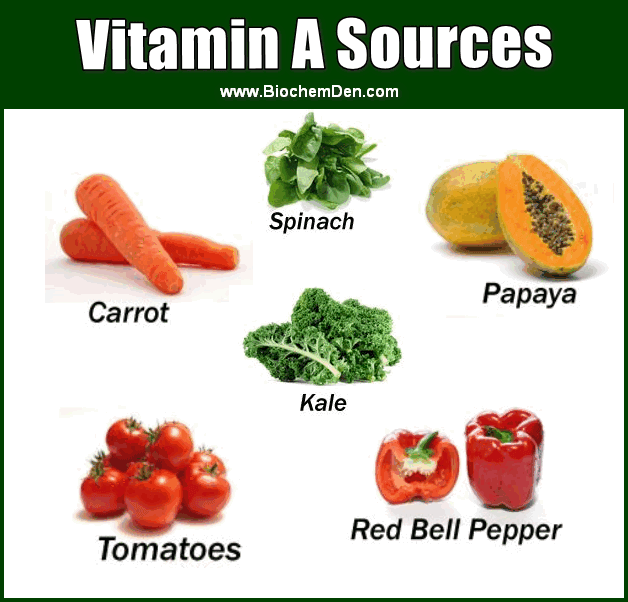
Structure of Vitamin A
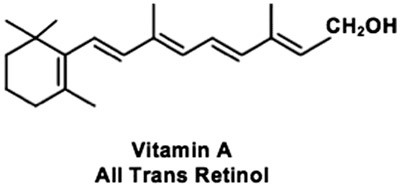
It contains a beta-iodine ring and a side chain. The side chain consists of two isoprene units, four double bonds, and one alcoholic group.
Chemical names
| Retinol (A1) | C20H30O |
| 3-dehydroretinol (A2) | C20H28O |
Chemical Properties
- It is a colorless, oily substance. It forms a transient blue color with saturated “antimony trichloride” (AnCl3). ( It is an important principle in the “Cataract” method used to determine vitamin A.
- Vitamin A absorbs UV light. It shows maximum absorption at 325 nm.
- It is quite stable without air and light. Furthermore, it creates esters with higher fatty acids.
- Additionally, it is soluble in fat solvents and fats. but insoluble in water.
Biochemical Functions
1. Visual cycle
Rhodopsin plays a pivotal role in vision. It is a membrane protein found in the photoreceptor cells of the retina. The proteins are oriented in such a way that their N-terminal ends face the intradermal space of the receptor matrix.
Rhodopsin is made up of the protein Opsin and 11-cis-retinal, attached through a Schiff baser to a lysine residue of the protein. The 11-cis-retinal is photosensitive.
When light falls on the retina, the 11-cis-retinal isomerases turn into all-trans-retinal. This creates a series of unstable molecules, and the Schiff base linkage is finally broken. Then all-trans-retinal is released from the protein. Opsin remains in the retina. But trans-retinal enters the blood circulation.
The main role of vitamin A is vision. The retina contains two types of light receptors, i.e., “rods” and “cones”.
- Rods function in dim light but do not recognize color.
- Cones function in bright light and are responsible for color vision. Rods contain the proteins “opsin” and “11-cis retinol”, which is a prosthetic group.
11-cis retinol is synthesized from trans retinol. All trans-retinol is converted into 11-cis-trans retinal by several steps. Rods absorb light within picoseconds. It undergoes several changes, i.e., 11-cis retinol is converted to trans retinol.
Thus, trans retinol is dissociated from Opsin and transported to the liver. Where it is converted to 11-cis retinal. It is ready for another visual cycle.
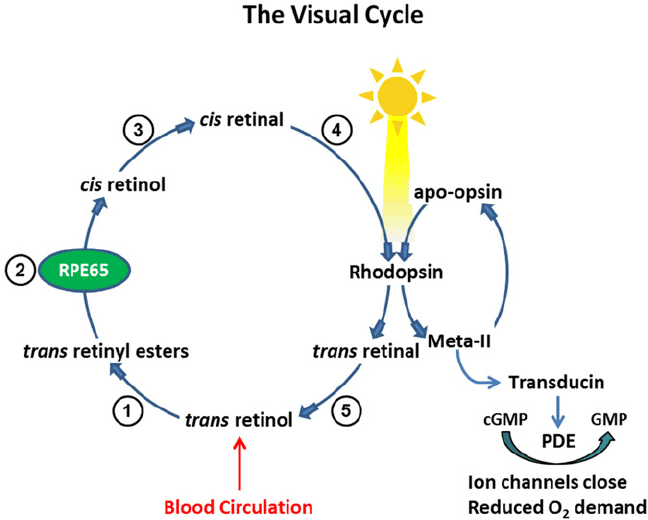
Cycle diagram
2. Other Biochemical Functions
- Vitamin A is necessary for the maintenance of normal epithelium and skin.
- Retinoic acid is found to have an important role in glycoprotein synthesis.
- Retinoyl phosphate acts as a donor of oligosaccharide units across the lipid bilayer of the cell.
- Retinol acts as a steroid hormone in controlling the expression of certain genes. This may account for the requirement for vitamin A for normal reproduction.
- Vitamin A is required for “sulfation” of the mucopolysaccharides in the matrix of bone.
Deficiency Disorders
Here are the vitamin deficiency symptoms:
- Night Blindness: In the early stage of vitamin A deficiency, individuals cannot see well in dim light. This condition is called “Night Blindness” (or) “Nyctalopia”. This is due to an inadequate amount of vitamin A required for the regeneration of “Rhodopsin.”
- Xerophthalmia: In this condition, lachrymal glands get keratinized and stop secreting. Thus, the eyes become dry. This is due to a deficiency of vitamin A.
- If xerosis of the conjunctiva and cornea is severe, it leads to a condition called “keratomalacia”. Symptoms are “metaplasia” and “degeneration of the corneal epithelium.”
Overdose of Vitamin A
The side effects of too much vitamin A cause serious problems in pregnant women. They are fatigue, brittle bones, joint pain, vomiting, and severe gastrointestinal distress.
If pregnant women take an excessive amount of vitamin A, it leads to a serious problem for the unborn child, including birth defects. The recommended RDA values are given below.
What are the benefits of vitamin A?
Here are a few of the benefits of vitamin A. They are
- It protects your eyes from age-related issues with vision and night blindness.
- It protects against some types of cancer.
- It gives good strength to the immune system.
- It gives good support for your bone health.
- It promoted healthy growth and reproduction.
Frequently Asked Questions (FAQs) on Vitamin A
Which foods are high in vitamin A?
The best sources of vitamin A are Cod liver oil, Eggs, Fortified breakfast cereals, fortified skim milk, orange, Yellow vegetables, fruits, Other sources of beta-carotene such as broccoli, spinach, the darkest green, and leafy vegetables.
What does vitamin A do in the human body?
Vitamin A is insoluble in water and soluble in Fats (So it is called “Fat-soluble vitamin”). It is essential for normal vision, immune system development, and reproduction. It also helps sensitive organ developments like Lungs, Kidneys, and other organs.
How do we get vitamin A?
To get a good amount of vitamin A, we have to take the good sources of beta-carotene in our diet. It will convert into vitamin A in our body. The good sources are Yellow, red, and green leafy vegetables – spinach, sweet potatoes, carrots, and red pepper. Yellow fruits like papaya, apricots, and mango are other good sources of vitamin A-rich foods.
What is the recommended dose of vitamin A?
According to RDA (Recommended Dietary Allowance) Values, here are the vitamin dosage per day
1. For men – 900 mcg per day,
2. For Women – 700 mcg per day,
3. For Pregnant Women – 700 mcg per day,
4. For breast-feeding women – 1300 mcg daily
Focus Points
- What is the storage form of vitamin A? It is a retinyl palmitate. Its overdose causes injury to lysosomes.
- Retinal is a visual pigment.
- Which is the carrier for oligosaccharides in glycoprotein synthesis? Retinoic acid
Vitamin A is a vital nutrient that is essential for human health. It helps the body to form cell membranes and performs numerous other functions, including aiding in the absorption of other nutrients. In this blog post, we provide a detailed overview of the vitamin A structure and properties, as well as explain how it is helpful for students.
By reading this blog, you will be able to better understand why it is important to include this nutrient in your diet and why students should be especially diligent in ensuring they are getting enough of it. Do you have any questions about vitamin A? Let us know in the comments below!
Discover more from Biochemistry Den
Subscribe to get the latest posts sent to your email.

